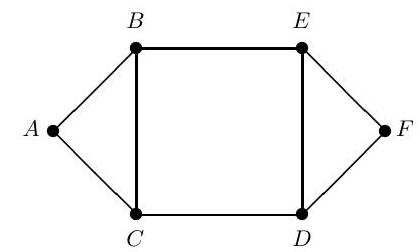Paper 1, Section II, H
Consider a particle moving between the vertices of the graph below, taking steps along the edges. Let be the position of the particle at time . At time the particle moves to one of the vertices adjoining , with each of the adjoining vertices being equally likely, independently of previous moves. Explain briefly why is a Markov chain on the vertices. Is this chain irreducible? Find an invariant distribution for this chain.

Suppose that the particle starts at . By adapting the transition matrix, or otherwise, find the probability that the particle hits vertex before vertex .
Find the expected first passage time from to given no intermediate visit to .
[Results from the course may be used without proof provided that they are clearly stated.]